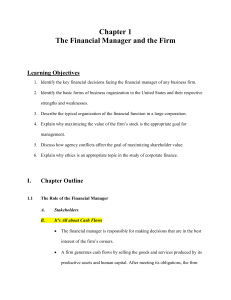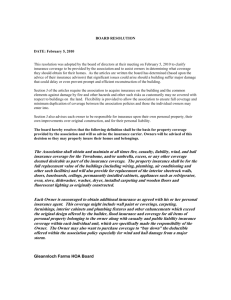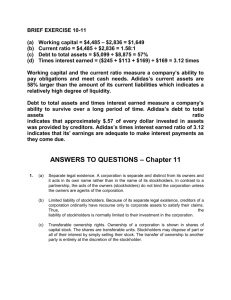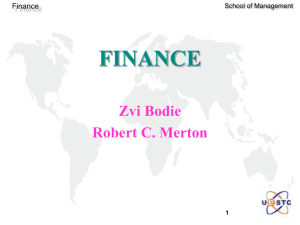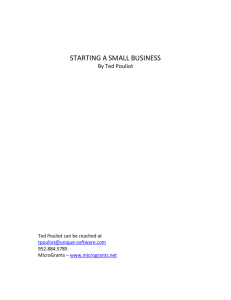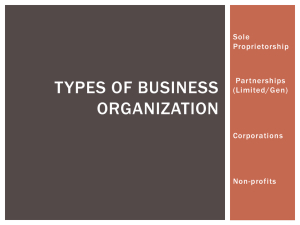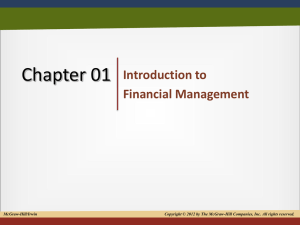Chapter 1
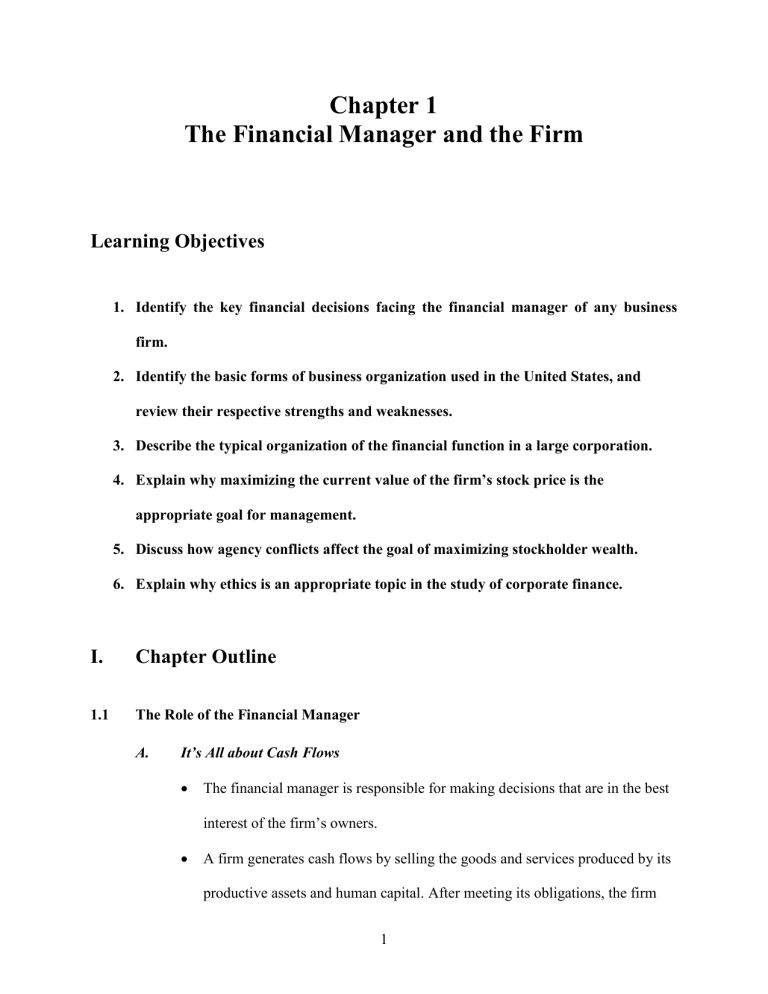
Chapter 1
The Financial Manager and the Firm
Learning Objectives
1.
Identify the key financial decisions facing the financial manager of any business firm.
2.
Identify the basic forms of business organization used in the United States, and review their respective strengths and weaknesses.
3.
Describe the typical organization of the financial function in a large corporation.
4.
Explain why maximizing the current value of the firm’s stock price is the appropriate goal for management.
5.
Discuss how agency conflicts affect the goal of maximizing stockholder wealth.
6.
Explain why ethics is an appropriate topic in the study of corporate finance.
I. Chapter Outline
1.1 The Role of the Financial Manager
A.
It’s All about Cash Flows
The financial manager is responsible for making decisions that are in the best interest of the firm’s owners.
A firm generates cash flows by selling the goods and services produced by its productive assets and human capital. After meeting its obligations, the firm
1
can pay the remaining cash, called residual cash flows, to the owners as a cash dividend, or it can keep the money and reinvest the cash in the business.
A firm is unprofitable when it fails to generate sufficient cash flows to pay operating expenses, creditors, and taxes. Firms that are unprofitable over time will be forced into bankruptcy by their creditors. In bankruptcy, the company will be reorganized, or the company’s assets will be liquidated, whichever is more valuable. If anything is left after all creditor and tax claims have been satisfied, which usually does not happen, the remaining cash, or residual, is distributed to the owners.
B. Three Fundamental Decisions in Financial Management
The capital budgeting decision: Which productive assets should the firm buy? This the most important decision because they drive the firm’s success or failure.
The financing decision: How should the firm finance or pay for assets?
Working capital management decisions: How should day-to-day financial matters be managed so that the firm can pay its bills, and how should surplus cash be invested?
1.2 Forms of Business Organization
A. A sole proprietorship is a business owned by one person.
2
There is also no legal distinction between personal and business income for a sole proprietor.
All business income is taxed as personal income.
A sole proprietor is responsible for paying all the firm’s bills and has unlimited liability for all business debts and other obligations of the firm.
B. A partnership consists of two or more owners joined together legally to manage a business.
A general partnership has the same basic advantages and disadvantages as a sole proprietorship.
When a transfer of ownership takes place, such as when a partner wants to sell out, the partnership is terminated, and a new partnership is formed. o The problem of unlimited liability can be avoided in a limited partnership where there must still be a general partner with unlimited liability.
C. Corporations are legal entities authorized under a state charter.
In a legal sense, it is a “person” distinct from its owners.
The owners of a corporation are its stockholders, or shareholders.
A major advantage of the corporate form of business is that stockholders have limited liability for debts and other obligations of the corporation.
A major disadvantage of corporate organization is taxes.
3
o The owners of corporations are subject to double taxation—first at the corporate level and then at the personal level when dividends are paid to them.
Some operate as a public corporation, which can sell their debt or equity in the public securities markets.
Others operate as a private corporation, where the common stock is often held by a small number of investors, typically the management and wealthy private backers.
D. Hybrid Forms of Business Organization
Limited liability partnerships (LLPs) combine the limited liability of a corporation with the tax advantage of a partnership—there is no double taxation.
Limited liability companies (LLCs)
Professional corporations (PCs)
1.3 Managing the Financial Function
A. The Chief Executive Officer
Has the ultimate management responsibility and decision-making power in the firm.
Reports directly to the board of directors, which is accountable to the company’s owners.
B. The Chief Financial Officer
4
Has the responsibility for seeing that the best possible financial analysis is presented to the CEO, along with an unbiased recommendation.
The CFO’s Key Financial Reports o The controller typically prepares the financial statements, oversees the firm’s financial and cost accounting systems, prepares the taxes, and works closely with the firm’s external auditors. o The treasurer looks after the collection and disbursement of cash, investing excess cash so that it earns interest, raising new capital, handling foreign exchange transactions, and overseeing the firm’s pension fund managers. o The internal auditor is responsible for in-depth risk assessments and for performing audits of areas that have been identified as high-risk areas, where the firm has the potential to incur substantial losses.
C. External Auditors
Provide an independent annual audit of the firm’s financial statements. o Ensure that the financial numbers are reasonably accurate and that accounting principles have been consistently applied year to year and not in a manner that significantly distorts the firm’s performance.
D. The Audit Committee
Approves the external auditor’s fees and engagement letter. The external auditor cannot be fired or terminated without the audit committee’s approval.
5
1.4 The Goal of the Firm
A. What Should Management Maximize?
Minimizing risk or maximizing profits without regard to the other is not a successful strategy.
B. Why Not Maximize Profits?
To a skilled accountant, however, a decision that increases profits under one set of accounting rules can reduce it under another.
Accounting profits are not necessarily the same as cash flows.
The problem with profit maximization as a goal is that it does not tell us when cash flows are to be received.
Profit maximization ignores the uncertainty or risk associated with cash flows.
C. Maximizing the Value of the Firm’s Stock Price
When analysts and investors determine the value of a firm’s stock, they consider:
1.
the size of the expected cash flows,
2.
the timing of the cash flows, and
3.
the riskiness of the cash flows.
Thus, the mechanism for determining stock prices overcomes all the cash-flow objections we raised with regard to profit maximization as a goal.
D. Can Management Decisions Affect Stock Prices?
6
Yes, management makes a series of decisions when executing the firm’s strategy that affect the firm’s cash flows and, hence, the price of the firm’s stock.
1.5 Agency Conflicts: Separation of Ownership and Control
A. Ownership and Control
For a large corporation, the ownership of the firm is spread over a huge number of shareholders and the firm’s owners may effectively have little control over management where management may make decisions that benefit their selfinterest rather than those of the stockholders.
B. Agency Relationships
An agency relationship arises whenever one party, called the principal, hires another party, called the agent, to perform some service or represent the principal’s interest.
C. Do Managers Really Want to Maximize Stock Price?
Shareholders own the corporation, but managers control the money and have the opportunity to use it for their own benefit.
D. Agency Costs
The costs of the conflict of interest between the firm’s owners and its management.
7
E. Aligning the Interests of Management and Stockholders
Management Compensation: A significant portion of management compensation is tied to the performance of the firm, usually to the firm’s stock price.
Control of the Firm: If the interests of the manager and the firm are not aligned, then eventually the firm will underperform relative to its true potential, and the firm’s stock price will fall below its maximum potential price. With its stock underpriced, the firm will become a prime target for a takeover by so-called corporate raiders or by other corporate buyers.
Management Labor Market o Firms that have a history of poor performance or a reputation for “shady operations” or unethical behavior have difficulty hiring top managerial talent. o The penalty for extremely poor performance or a criminal conviction is a significant reduction in the manager’s lifetime earnings potential.
Managers know this, and the fear of such consequences helps keep them working hard and honestly.
An Independent Board of Directors : Regulators believe one of the primary reasons for misalignment between board members’ and stockholders’ interests is the lack of board independence.
F. Sarbanes-Oxley and other regulatory reforms include
Greater board independence
8
Internal accounting controls
Compliance programs
Ethics program
Expansion of audit committee’s oversight powers
1.6 The Importance of Ethics in Business
A. Business ethics— a society’s ideas about what actions are right and wrong.
B. Are Business Ethics Different?
Studies suggest that traditions of morality are very relevant to business and to financial markets in particular.
Corruption in business creates inefficiencies in an economy, inhibits the growth of capital markets, and slows a country’s rate of economic growth.
C. Types of Ethical Conflicts in Business
Conflicts of Interest— occur when a conflict arises between a person’s personal or institutional gain and the obligation to serve the interest of another party.
Information Asymmetry— occurs when one party in a business transaction has information that is unavailable to the other parties in the transaction.
D. The Law Is Not Enough. Ethicists argue, however, that laws and market forces are not enough. Despite heavy regulation, the sector has a long and rich history of financial scandals.
9
E. The Importance of an Ethical Business Culture. An ethical business culture means that people have a set of principles that helps them identify moral issues and then make ethical judgments without being told what to do.
F. Serious Consequences. In recent years, the “rules” have changed, and the legal cost of ethical mistakes can be extremely high.
10
11
